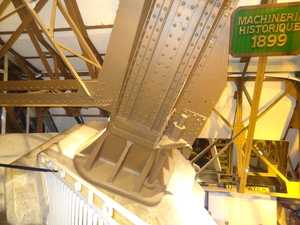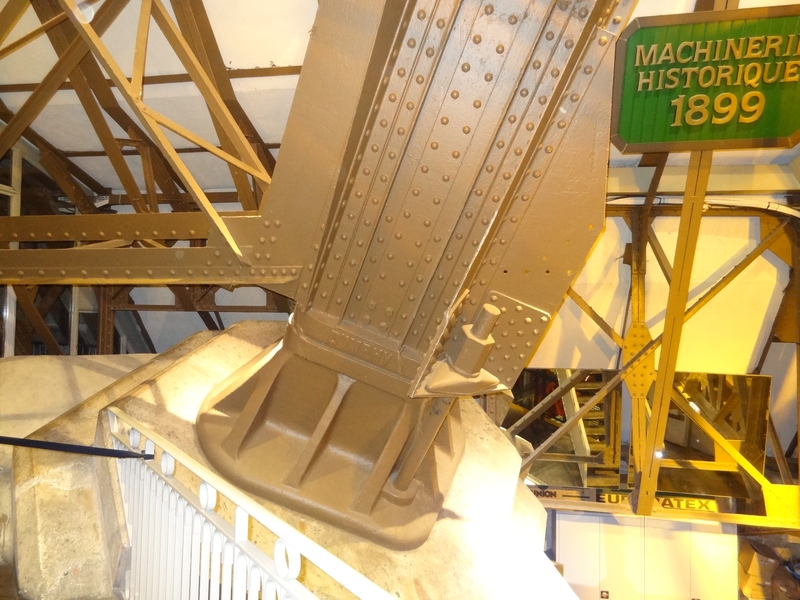What weight does the Eiffel Tower? A priori it seems simple enough to find since it is enough to sum the weights of all the components of the structure. And in practice, this is indeed the case, but we must still not be redundant. To calculate the total weight of the Eiffel Tower you have to take into account:
- Weight the metal structure
- The weight of lifts
- The weight of various installations on the platforms
So, what's his weight?
10 100 tons
Nowadays, it's a little less because it was lightened in the 80s, but it's an approximate figure. To this weight must be added the foundations, foundations and masonry. The distribution is done as well.
Weight of the metal structure
The various pieces metal were provided for a large part by the Levallois-Perret workshops, which facilitates their accounting. The bills of mail for irons and irons indicate a weight of 6 360 667 Kg. The rest comes from various suppliers, that makes 981 147 Kg for various small equipments and especially the rivets, which casually make their weight. It gives us a total weight of 7,341,214 kg, more than 7,300 tonnes.
To be more precise it is necessary to distribute the weight of the rivets on the parts which they must ensure the assembly, one can thus indicate the following distribution:
- Supports and anchors: 165 628 Kg
- Underbody of the batteries: 164 492 Kg
- Special frame in the pile 3: 42 831 Kg
- Otis Lift Cylinder Support Beams: 56,461 Kg
- Metal structure: 6,911,862 Kg
We even have the details of the various elements of the structure, weight by weight. Thus we know that the panels 1 to 4 which constitute the 4 pillars, from the ground to the last level before the 1st floor, make a total of 1 570 948 Kg. The panel 5 which supports the first floor, and which consists of heavy beams , made alone 1,512,609 Kg, floor and gallery included. At this level there are also the decorative arches to take into account, they still weigh 770 217 Kg. Then comes the panels 6 to 10, which correspond to the continuation of the elevation of the pillars up to the level preceding the 2nd floor . Together they make 1,213,204 kg. Panel 11, with the floor of the second floor, is 482,955 kg, more than 3 times less than for the first floor. The panels 12 to 18 constitute the final elevation of the tower, when the four pillars are united into a single element. They make 695,364 kg. The panel 19 supports the intermediate floor, it has a weight of 92,654. It is the first element to have less than 100 tons. Above are the panels 20 to 28 leading to the third floor, they are 389 394 Kg. Finally, the panel 29, the last, weighs 114 614 Kg with the floor of the 3rd floor. Only missing the bell tower, at the time it existed, it weighed 68 816 Kg nearly 69 tons.
The metal structure is the sum of all these weights, a total of: 7 341 214 Kg. All these figures correspond to the weight of the tower at the time of its construction, nowadays the tower is a little lighter.
Elevator weight
Otis lifts
In his book, 'The Tower of 300m', Gustave Eiffel describes in a much more precise way the weight of most elements constituting his monument. Thus we can read the details of the elevators, which are, for Otis lifts:
- Hydraulic cylinder: 20,000 Kg
- Pistons, rods and their support: 4,500 Kg
- Traveling pulley trolley: 10,000 Kg
- Distributors and operating levers: 800 Kg
- Circulation pipes and top distributor: 1,500 Kg
- Fixed pulleys of the halyard, shaft and bearings: 6 300 Kg
- Counterbalance carriages, rollers and safety devices: 4,500 Kg
- Cab and roller frame: 4,500 Kg
- Safety devices of this chassis: 1500 Kg
- Auxiliary pulleys and fixed part of the counterweight: 1,200 Kg
- Miscellaneous Mechanisms and Maneuvering Devices: 5 750 Kg
- A total of 64 750 kg, almost 65 tonnes.
That's the weight of the parts provided by Otis. To this must be added the following items, which have been provided by various companies on behalf of these elevators. There is :
- Support beams for cylinders: 27,362 Kg
- Support beams support: 3,952 Kg
- Cast iron supports: 1,773 Kg
- Automatic and guide pulleys: 8 881 Kg
- Various pulleys: 4,636 Kg
- Track Rails: 13,389 Kg
- Bearing cushions: 3,475 Kg
- Rectangular tank at the bottom of the lift: 1,285 Kg
- Large cylindrical tank of the 2nd floor: 3,471 Kg
- Special channelization: 734 Kg
- Cables: 2,750 Kg
- Pebble supports: 1,009 Kg
- Counterweight in cast iron: 16,192 Kg
- Riblons 5 680 Kg
- Supply containers and their chains: 1,032 Kg
- Copper piping: 250 Kg
- General Pipeline: 9,000 Kg
- Crate case: 5,000 Kg
- A total of: 109,859 Kg
It is by adding the two weights that we find the total weight of an Otis lift: 174 609 Kg. Given that there are two, the weight attributed to this type of lift is 249 218 Kg, almost 250 tons.
Roux, Combaluzier and Lepape lifts
In the same way we have a written record of the details of the weight of the various elements that constituted the elevators Roux, Combaluzier and Lepape. These elevators were dismantled in 1910, but these figures give some idea of the weight of the elevators that replaced them.
- 2 cylinders in sheet metal and plungers in cast iron: 24 275 Kg
- 2 cylinders support: 8,775 Kg
- 2 clevises at the head of the divers and pulleys: 8 988 Kg
- 2 bottom bed bases: 2,817 Kg
- 2 slides of the divers: 5 476 Kg
- 2 boxes with Galle gables: 3,365 Kg
- 2 driving wheels: 7,936 Kg
- 2 drive shafts: 3,995 Kg
- 24 teeth drive wheels and bolts: 1,628 Kg
- 2 upper idler pulleys: 3,976 Kg
- Gaines wrapping drive wheels and idlers: 26 270 Kg
- Inlet pipes with cylinders: 108 Kg
- Miscellaneous: 2,088 Kg
That's a total of 99,697 kg (about 100 tonnes) plus 576 kg of various mechanisms, which gives 100,273 kg. But this weight is really only half the weight of these lifts, because as for Otis we must add the material of various suppliers, which is detailed as follows:
- Current sheaths: 40 610 Kg
- Pistons and tensioners: 14 565 Kg
- Galle Chain: 11,237 Kg
- Grease boxes and axles: 1,750 Kg
- Various pipes: 2,367 Kg
- Maneuvering and distribution mechanism: 3,000 Kg
- Self-propelled stop mechanism: 1,618 Kg
- A double cabin: 6 400 Kg
- Track Rails: 2,016 Kg
- Half of the general pipeline: 9,000 Kg
- Half sheet metal tanks, pipe supports, etc. : 4,304 Kg
- Bolts and various parts: 1 551 Kg
- This gives a total of 98,418 Kg
It can be deduced that a Roux, Combaluzier and Lepape lift weighs 198,418 Kg, or nearly 200 tonnes, which is 1/5e lighter than an Otis lift.
In conclusion, the total weight of the elevators, along with their equipment, is 1 036 777 Kg
Misc Installations and Platforms
The rest of the weight of the tower is in various elements installed along the water. Let's start with an element that has disappeared, nowadays: the campanile. It contained 34,070 Kg of miscellaneous equipment, including a plank floor, 7 partitions, or zinc cover and the lighthouse and lanterns therein.
On the 3rd floor, the floor, the exterior partitions and the shops are counted for a weight of 33,290 Kg. The intermediate floor, which is not used today, weighs 2,600 Kg. The 2nd floor is much more There are 225,330 kg of guardrails, floors, mats, galleries, shelters and various shops. And of course it is the first floor which is the heaviest, question external facilities: It weighed 1 455 401 Kg, for all the restaurants and shops which were there, for the arcardes, the mats, the covers, the gutters etc. Of course nowadays this weight is greatly diminished because the first floor has been greatly refined, it remains only the 3 modern pavilions, not heavy, and some relatively lightweight architectural elements, such as elevator guards or kiosks presentation of the tower's history.
The total of these various installations makes 1 750 911 Kg.
Resume
In the end, the tower is 6 911 802 + 1 036 777 + 1 750 911 = 9 699 490 kg, or 9 700 tonnes!
It is now that the calculation is complicated, because this weight of 9700 tons admitted, one realizes that one did not count the bases, nor the foundations, and no more the masonry of the piles. On closer inspection there are also no hooves and counter-shoes that connect the metal structure to the masonry (It's a kind of gigantic joint) and various other things. Fortunately these weights are known:
- Metal caisson foundations: 216 152 Kg
- Cast iron pipes for electricity: 31 450 Kg
- Cast iron support: 165,628 kg
- Mechanical components of lifts: 916 000 kg
- Otis cylinder beams: 50 463 Kg
- Battery basements: 161 492 Kg
- Frame of the stack 3: 42 831 Kg
Ground pressure
The interest in knowing the weight of the Eiffel Tower, apart from increasing our knowledge, is to calculate the pressure it exerts on the ground. This pressure is precisely one of the main grievances that we made to the tower, before its construction.

The crossbow junction-masonry junction
A massif measures approximately 5.5 x 3.5m on the ground, ie 19.25 m2. Convert. 631.25 tonnes = 631,250 kg and 19.25 m2 = 192,500 cm2. So we have 631,250 / 192,500 = 3.28 Kg per cm2.
The pressure on the ground is 3.28 kg / cm2, which is quite acceptable and very close to the normal pressure of a building
See also:





















